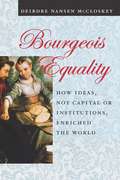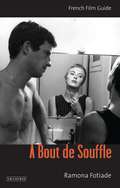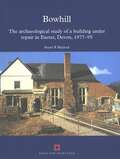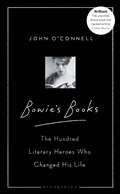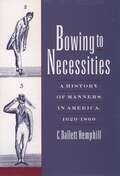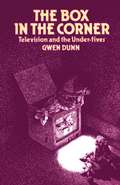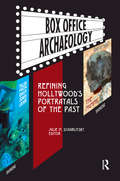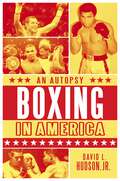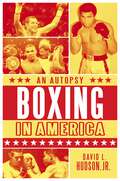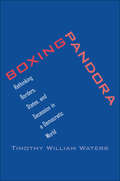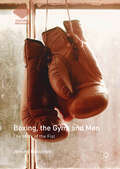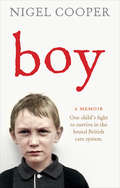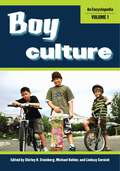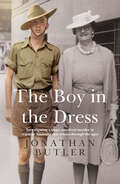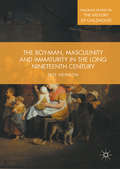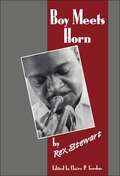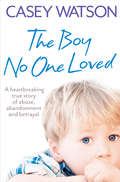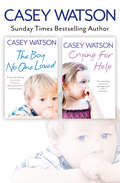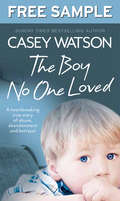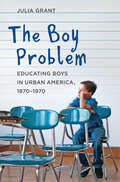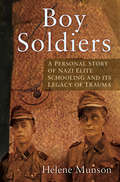- Table View
- List View
Bourgeois Equality: How Ideas, Not Capital or Institutions, Enriched the World
by Deirdre N. McCloskeyThere’s little doubt that most humans today are better off than their forebears. Stunningly so, the economist and historian Deirdre McCloskey argues in the concluding volume of her trilogy celebrating the oft-derided virtues of the bourgeoisie. The poorest of humanity, McCloskey shows, will soon be joining the comparative riches of Japan and Sweden and Botswana. Why? Most economists—from Adam Smith and Karl Marx to Thomas Piketty—say the Great Enrichment since 1800 came from accumulated capital. McCloskey disagrees, fiercely. “Our riches,” she argues, “were made not by piling brick on brick, bank balance on bank balance, but by piling idea on idea.” Capital was necessary, but so was the presence of oxygen. It was ideas, not matter, that drove “trade-tested betterment.” Nor were institutions the drivers. The World Bank orthodoxy of “add institutions and stir” doesn’t work, and didn’t. McCloskey builds a powerful case for the initiating role of ideas—ideas for electric motors and free elections, of course, but more deeply the bizarre and liberal ideas of equal liberty and dignity for ordinary folk. Liberalism arose from theological and political revolutions in northwest Europe, yielding a unique respect for betterment and its practitioners, and upending ancient hierarchies. Commoners were encouraged to have a go, and the bourgeoisie took up the Bourgeois Deal, and we were all enriched. Few economists or historians write like McCloskey—her ability to invest the facts of economic history with the urgency of a novel, or of a leading case at law, is unmatched. She summarizes modern economics and modern economic history with verve and lucidity, yet sees through to the really big scientific conclusion. Not matter, but ideas. Big books don’t come any more ambitious, or captivating, than Bourgeois Equality.
A Bout De Souffle: French Film Guide (Ciné-File French Film Guides)
by Ramona FotiadeOne of the most charismatic feature films of the New Wave, A Bout de Souffle (1960) has retained much of its appeal not only as the emphatic statement of a generational break with tradition, but also as Godard's earliest rendition of a set of thematic and stylistic motifs that would become his trademark. Sustained critical attention over almost fifty years has made this a cult film, propelled in part by the memorable coupling of its lead actors, Jean-Paul Belmondo and Jean Seberg, whose story on screen seemed to portray the troubled love affair between French cinema and Hollywood.In this original guide to the film, Ramona Fotiade provides an in-depth analysis of its production and reception contexts, as well as of salient aspects mise-en-scene and editing. She situates A Bout de Souffle in relation to Godard's filmography and critical writings up to 1960, focusing on the elaboration of a narrative and visual discourse that has come to be identified with a distinctive strand in postmodern French cinema. She also explores the impact of Godard's early counter-narrative and visual strategies on the independent American filmmakers and the French Cinema du Look during the 1980s and 1990s.
Bowhill: The archaeological study of a building under repair in Exeter, Devon, 1977-95 (English Heritage)
by Stuart R BlaylockBowhill is an important late medieval house near Exeter. This monograph demonstrates how examination of its historical development and the material of its construction were used to deepen understanding about it and to inform a repair programme. This approach combines the disciplines of documentary research, detailed fabric stratigraphic analysis, and architectural and technological history. English Heritage commissioned Exeter Archaeology, as leaders in the field of what is now called 'buildings archaeology', to carry out this study. The house was owned by two prominent West-Country families, the Holands and the Carews, and remained in the ownership of Carew descendants until the 1930s. From the early 18th century the house was tenanted, and much of its interest, if not its survival, is due to a long period of slow decline and limited adaptation. In 1976 the government purchased the building. This book is about the archaeological study of the building in its widest sense - covering the buried remains, the standing fabric, artefacts, building materials, and pictorial and documentary sources - in the context of the repairs carried out over almost twenty years by English Heritage. In addition, the book aims to act as a guide to the hidden fabric of the building - exposed and recorded during repairs, but now covered once again - and to provide the background to some of the ground-breaking applied research that was used in its conservation. This integrated exercise in applied history will appeal to architectural historians, to archaeologists and to conservation professionals, both from scholarly and from technical backgrounds.
Bowie's Books: The Hundred Literary Heroes Who Changed His Life
by John O'Connell'Brilliant. The unwritten Bowie book that needed writing' CAITLIN MORAN'What is your idea of perfect happiness?' 'Reading.''What is the quality you most like in a man?''The ability to return books.'Three years before he died, David Bowie made a list of the one hundred books that had transformed his life – a list that formed something akin to an autobiography. From Madame Bovary to A Clockwork Orange, the Iliad to the Beano, these were the publications that had fuelled his creativity and shaped who he was. In Bowie's Books, John O'Connell explores this list in the form of one hundred short essays, each offering a perspective on the man, performer and creator that is Bowie, his work as an artist and the era that he lived in.Bowie's Books is much more than a list of books you should read in your lifetime: it is a unique insight into one of the greatest minds of our times, and an indispensable part of the legacy that Bowie left behind.
Bowie's Books: The Hundred Literary Heroes Who Changed His Life
by John O'ConnellA TIMES BOOK OF THE YEAR'Brilliant. The unwritten Bowie book that needed writing' CAITLIN MORAN'Splendid. Provides plenty of evidence of Bowie's restless, rummaging intelligence, and his pleasure in the fact that books allow readers to slip into someone else's skin and try it on for size' THE TIMES'A witty and enlightening analysis of Bowie's 100 essential books . . . A handy, amusing, light-touch precis' OBSERVER'What is your idea of perfect happiness?' 'Reading.''What is the quality you most like in a man?''The ability to return books.'Three years before he died, David Bowie made a list of the one hundred books that had transformed his life – a list that formed something akin to an autobiography. From Madame Bovary to A Clockwork Orange, the Iliad to the Beano, these were the publications that had fuelled his creativity and shaped who he was. In Bowie's Books, John O'Connell explores this list in the form of one hundred short essays, each offering a perspective on the man, performer and creator that is Bowie, his work as an artist and the era that he lived in.Brilliantly illustrated throughout and the perfect gift for Bowie fans and book lovers, Bowie's Books is much more than a list of books you should read in your lifetime: it is a unique insight into one of the greatest minds of our times, and an indispensable part of the legacy that Bowie left behind.
Bowing to Necessities: A History of Manners in America, 1620-1860
by C. Dallett HemphillAnglo-Americans wrestled with some profound cultural contradictions as they shifted from the hierarchical and patriarchal society of the seventeenth-century frontier to the modern and fluid class democracy of the mid-nineteenth century. How could traditional inequality be maintained in the socially leveling environment of the early colonial wilderness? And how could nineteenth-century Americans pretend to be equal in an increasingly unequal society? Bowing to Necessities argues that manners provided ritual solutions to these central cultural problems by allowing Americans to act out--and thus reinforce--power relations just as these relations underwent challenges. Analyzing the many sermons, child-rearing guides, advice books, and etiquette manuals that taught Americans how to behave, this book connects these instructions to individual practices and personal concerns found in contemporary diaries and letters. It also illuminates crucial connections between evolving class, age, and gender relations. A social and cultural history with a unique and fascinating perspective, Hemphill's wide-ranging study offers readers a panorama of America's social customs from colonial times to the Civil War.
Bowing to Necessities: A History of Manners in America, 1620-1860
by C. Dallett HemphillAnglo-Americans wrestled with some profound cultural contradictions as they shifted from the hierarchical and patriarchal society of the seventeenth-century frontier to the modern and fluid class democracy of the mid-nineteenth century. How could traditional inequality be maintained in the socially leveling environment of the early colonial wilderness? And how could nineteenth-century Americans pretend to be equal in an increasingly unequal society? Bowing to Necessities argues that manners provided ritual solutions to these central cultural problems by allowing Americans to act out--and thus reinforce--power relations just as these relations underwent challenges. Analyzing the many sermons, child-rearing guides, advice books, and etiquette manuals that taught Americans how to behave, this book connects these instructions to individual practices and personal concerns found in contemporary diaries and letters. It also illuminates crucial connections between evolving class, age, and gender relations. A social and cultural history with a unique and fascinating perspective, Hemphill's wide-ranging study offers readers a panorama of America's social customs from colonial times to the Civil War.
Box Office Archaeology: Refining Hollywood’s Portrayals of the Past
by Julie M. Schablitsky“How true is it?” is a common refrain of patrons coming out of movie theatres after the latest film on pirates, Vikings, or mummies. While Hollywood usurps the past for its own entertainment purposes, archaeologists and historians know a lot about many of these subjects, digging up stories often more fascinating than the ones projected on screen. This distinguished group of archaeologists select key subjects and genres used by Hollywood and provide the historical and archaeological depth that a movie cannot—what really happened in history. Topics include Egypt, the Wild West, Civil War submarines, Vikings, the Titanic, and others. The book should be of interest to introductory archaeology and American history classes, courses on film and popular culture, and to a general audience. Alternate Selection, History Book Club.
Box Office Archaeology: Refining Hollywood’s Portrayals of the Past
by Julie M. Schablitsky“How true is it?” is a common refrain of patrons coming out of movie theatres after the latest film on pirates, Vikings, or mummies. While Hollywood usurps the past for its own entertainment purposes, archaeologists and historians know a lot about many of these subjects, digging up stories often more fascinating than the ones projected on screen. This distinguished group of archaeologists select key subjects and genres used by Hollywood and provide the historical and archaeological depth that a movie cannot—what really happened in history. Topics include Egypt, the Wild West, Civil War submarines, Vikings, the Titanic, and others. The book should be of interest to introductory archaeology and American history classes, courses on film and popular culture, and to a general audience. Alternate Selection, History Book Club.
Boxing in America: An Autopsy
by David L. Jr.This book presents a sweeping view of boxing in the United States and the influence of the sport on American culture.Boxing has long been a popular fixture of American sport and culture, despite its decidedly seedy side (the fact that numerous boxing champions acquired their skills in prison or reform schools, the corruption and greed of certain boxing promoters, and the involvement of the mob in fixing the outcome of many big fights). Yet boxing remains an iconic and widely popular spectator sport, even in light of its decline as a result of the recent burgeoning interest in mixed martial arts (MMA) contests. What had made this sport so enthralling to our nation for such a long period of time?This book contains much more than simple documentation of the significant dates, people, and bouts in the history of American boxing. It reveals why boxing became one of America's leading spectator sports at the turn of the century and examines the factors that have swayed the public's perception of it, thereby affecting its popularity. In Boxing in America, the author provides a compelling view of not only the pugilist sport, but also of our country, our sources of entertainment, and ourselves.
Boxing in America: An Autopsy
by David L. Jr.This book presents a sweeping view of boxing in the United States and the influence of the sport on American culture.Boxing has long been a popular fixture of American sport and culture, despite its decidedly seedy side (the fact that numerous boxing champions acquired their skills in prison or reform schools, the corruption and greed of certain boxing promoters, and the involvement of the mob in fixing the outcome of many big fights). Yet boxing remains an iconic and widely popular spectator sport, even in light of its decline as a result of the recent burgeoning interest in mixed martial arts (MMA) contests. What had made this sport so enthralling to our nation for such a long period of time?This book contains much more than simple documentation of the significant dates, people, and bouts in the history of American boxing. It reveals why boxing became one of America's leading spectator sports at the turn of the century and examines the factors that have swayed the public's perception of it, thereby affecting its popularity. In Boxing in America, the author provides a compelling view of not only the pugilist sport, but also of our country, our sources of entertainment, and ourselves.
Boxing Pandora: Rethinking Borders, States, and Secession in a Democratic World
by Timothy William WatersA timely and provocative challenge to the foundations of our global order: why should national borders be unchangeable? The inviolability of national borders is an unquestioned pillar of the post–World War II international order. Fixed borders are believed to encourage stability, promote pluralism, and discourage nationalism and intolerance. But do they? What if fixed borders create more problems than they solve, and what if permitting borders to change would create more stability and produce more just societies? Legal scholar Timothy Waters examines this possibility, showing how we arrived at a system of rigidly bordered states and how the real danger to peace is not the desire of people to form new states but the capacity of existing states to resist that desire, even with violence. He proposes a practical, democratically legitimate alternative: a right of secession. With crises ongoing in the United Kingdom, Spain, Ukraine, Iraq, Syria, Sudan, and many other regions, this reassessment of the foundations of our international order is more relevant than ever.
Boxing, the Gym, and Men: The Mark of the Fist (Cultural Sociology)
by Jérôme BeauchezThis book explores the lived experiences of boxers in a French banlieue, largely populated by people from working-class and immigrant backgrounds. Jérôme Beauchez, who joined in the men’s daily workouts for many years, analyzes the act of boxing as a high-stakes confrontation that extends well beyond the walls of the gym. Exploring the physical and existential realities of combat, the author provides a multifaceted “thick description” of this world and shows that the violence faced by the gym’s members is not so much to be found in the ring as in the adversity of everyday racism and social exclusion. Boxing can therefore be understood as an act of resistance that is about more than simply fighting an opponent and that reflects all the existential struggles facing these men who are both stigmatized and socially dominated by race and class.
Boy: One Child's Fight to Survive in the Brutal British Care System
by Nigel Cooper“My parents had to try for eighteen months to conceive me, but my father was adamant he wanted one last child. After eighteen months of trying, my mother eventually conceived and nine months later I was born. My birth was a difficult one. It was like I was never meant to be in this world.” Boy is Nigel Cooper’s memoir from the age of five to sixteen. It tells the shocking, brutal, disturbing, emotional story of his childhood spent in and out of various care homes and institutions during the 1970s and 1980s. When Nigel was just seven years old, after the untimely death of his sister and father, his mother asked social services to take him away – and then his nightmare began. For the next nine years of his life, Nigel was repeatedly rejected by his mother and spent his childhood among bullies, abusers, psychopaths and criminals. He spent time in a children’s psychiatric hospital, where they carried out unimaginable tests, pumped him full of drugs and physically abused him; care homes, where he would come face to face with rough estate kids who would beat him up, force him to steal for them and threaten his life; and barbaric assessment centres for disturbed and delinquent children, where the staff were, at times, sicker than the children.The system tried to break Nigel and it was a miracle that he survived. The British care system robbed him of his childhood. His story is truly extraordinary and will do a lot more than shed light on what it was like growing up during the Jimmy Savile years.Boy is powerfully written, edgy, gripping and beautifully crafted.
Boy Culture [2 volumes]: An Encyclopedia [2 volumes]
by Shirley R. Steinberg Michael Kehler Lindsay CornishIn this two-volume set, a series of expert contributors look at what it means to be a boy growing up in North America, with entries covering everything from toys and games, friends and family, and psychological and social development.Boy Culture: An Encyclopedia spans the breadth of the country and the full scope of a pivotal growing-up time to show what "a boy's life" is really like today. With hundreds of entries across two volumes, it offers a series of vivid snapshots of boys of all kinds and ages at home, school, and at play; interacting with family or knocking around with friends, or pursuing interests alone as they begin their journey to adulthood.Boy Culture shows an uncanny understanding of just how exciting, confusing, and difficult the years between childhood and young adulthood can be. The toys, games, clothes, music, sports, and feelings—they are all a part of this remarkable resource. But most important is the book's focus on the things that shape boyhood identities—the rituals of masculinity among friends, the enduring conflict between fitting in and standing out, the effects of pop culture images, and the influence of role models from parents and teachers to athletes and entertainers to fictional characters.
The Boy in the Dress
by Jonathan ButlerAll rights reserved. No part of this publication may be reproduced without prior permission of the publisher.
The Boy-Man, Masculinity and Immaturity in the Long Nineteenth Century (Palgrave Studies in the History of Childhood)
by Pete NewbonThis book explores the evolution of male writers marked by peculiar traits of childlike immaturity. The ‘Boy-Man’ emerged from the nexus of Rousseau’s counter-Enlightenment cultural primitivism, Sensibility’s ‘Man of Feeling’, the Chattertonian poet maudit, and the Romantic idealisation of childhood. The Romantic era saw the proliferation of boy-men, who congregated around such metropolitan institutions as The London Magazine. These included John Keats, Leigh Hunt, Charles Lamb, Hartley Coleridge, Thomas De Quincey and Thomas Hood. In the period of the French Revolution, terms of childishness were used against such writers as Wordsworth, Keats, Hunt and Lamb as a tool of political satire. Yet boy-men writers conversely used their amphibian child-adult literary personae to critique the masculinist ideologies of their era. However, the growing cultural and political conservatism of the nineteenth century, and the emergence of a canon of serious literature, inculcated the relegation of the boy-men from the republic of letters.
Boy Meets Horn
by Rex StewartOne of the most innovative and inventive soloists in jazz, cornetist Rex Stewart (1907-67) became known as a writer on jazz subjects. This work, his autobiography drafted at the time of his death, has been edited from its manuscript sources by Stewart's amanuensis, who edited his earlier posthumous collection Jazz Masters of the Thirties. With a selection of rare photographs from Stewart's own archive, and mss. facsimiles.
The Boy No One Loved: A Heartbreaking True Story Of Abuse, Abandonment And Betrayal
by Casey WatsonSunday Times bestselling author and foster carer Casey Watson’s first heartbreaking memoir. Justin was five years old; his brothers two and three. Their mother, a heroin addict, had left them alone again. Later that day, after trying to burn down the family home, Justin was taken into care.
The Boy No One Loved and Crying for Help 2-in-1 Collection
by Casey WatsonSunday Times bestselling author and foster carer Casey Watson’s first heartbreaking memoir The Boy No One Loved now combined in a single volume with her shocking title Crying for Help about a troubled 12-year-old girl.
The Boy No One Loved: Free Sampler
by Casey WatsonDiscover the incredible memoirs of internationally bestselling author Casey Watson with this free extended eBook sampler of Casey’s first book, and Sunday Times bestseller, The Boy No One Loved.
The Boy Problem: Educating Boys in Urban America, 1870–1970
by Julia GrantAmerica’s educational system has a problem with boys, and it’s nothing new.The question of what to do with boys—the "boy problem"—has vexed educators and social commentators for more than a century. Contemporary debates about poor academic performance of boys, especially those of color, point to a myriad of reasons: inadequate and punitive schools, broken families, poverty, and cultural conflicts. Julia Grant offers a historical perspective on these debates and reveals that it is a perennial issue in American schooling that says much about gender and education today.Since the birth of compulsory schooling, educators have contended with what exactly to do with boys of immigrant, poor, minority backgrounds. Initially, public schools developed vocational education and organized athletics and technical schools as well as evening and summer continuation schools in response to the concern that the American culture of masculinity devalued academic success in school. Urban educators sought ways to deal with the "bad boys"—almost exclusively poor, immigrant, or migrant—who skipped school, exhibited behavioral problems when they attended, and sometimes landed in special education classes and reformatory institutions. The problems these boys posed led to accommodations in public education and juvenile justice system.This historical study sheds light on contemporary concerns over the academic performance of boys of color who now flounder in school or languish in the juvenile justice system. Grant's cogent analysis will interest education policy-makers and educators, as well as scholars of the history of education, childhood, gender studies, American studies, and urban history.
The Boy Problem: Educating Boys in Urban America, 1870–1970
by Julia GrantAmerica’s educational system has a problem with boys, and it’s nothing new.The question of what to do with boys—the "boy problem"—has vexed educators and social commentators for more than a century. Contemporary debates about poor academic performance of boys, especially those of color, point to a myriad of reasons: inadequate and punitive schools, broken families, poverty, and cultural conflicts. Julia Grant offers a historical perspective on these debates and reveals that it is a perennial issue in American schooling that says much about gender and education today.Since the birth of compulsory schooling, educators have contended with what exactly to do with boys of immigrant, poor, minority backgrounds. Initially, public schools developed vocational education and organized athletics and technical schools as well as evening and summer continuation schools in response to the concern that the American culture of masculinity devalued academic success in school. Urban educators sought ways to deal with the "bad boys"—almost exclusively poor, immigrant, or migrant—who skipped school, exhibited behavioral problems when they attended, and sometimes landed in special education classes and reformatory institutions. The problems these boys posed led to accommodations in public education and juvenile justice system.This historical study sheds light on contemporary concerns over the academic performance of boys of color who now flounder in school or languish in the juvenile justice system. Grant's cogent analysis will interest education policy-makers and educators, as well as scholars of the history of education, childhood, gender studies, American studies, and urban history.
Boy Soldiers: A Personal Story of Nazi Elite Schooling and its Legacy of Trauma
by Helene MunsonAt the end of the Second World War, hundreds of thousands of German children were sent to the front lines in the largest mobilisation of underage combatants by any country before or since. Hans Dunker was just one of these children. Identified as extremely gifted aged 9, he left his home in South America in 1937 in pursuit of a ‘proper’ education in Nazi Germany. Instead, he and his schoolfriends, lacking adequate training, ammunition and rations, were sent to the Eastern Front when the war was already lost in the spring of 1945. Using her father’s diary and other documents, Helene Munson traces Hans’ journey from a student at Feldafing School to a soldier fighting in Zawada, a village in present-day Czech Republic. What is revealed is an education system so inhumane that until recently, post-war Germany worked hard to keep it a secret. This is Hans’ story, but also the story of a whole generation of German children who silently carried the shame of what they suffered into old age. It reveals the true cost and long-lasting impacts of such experiences – not just to them, but also to their families and future generations, a warning to a world where thousands of child soldiers are still sent to fight in armed conflicts.
